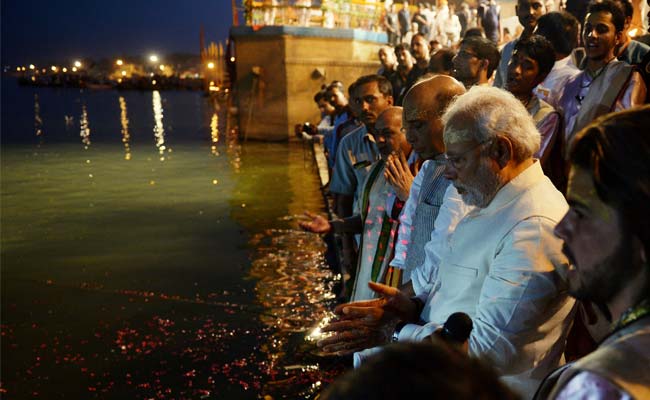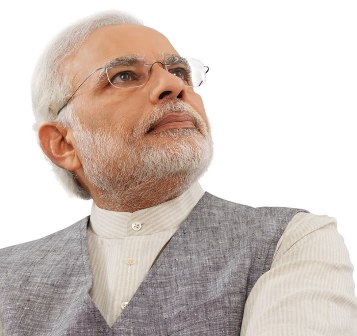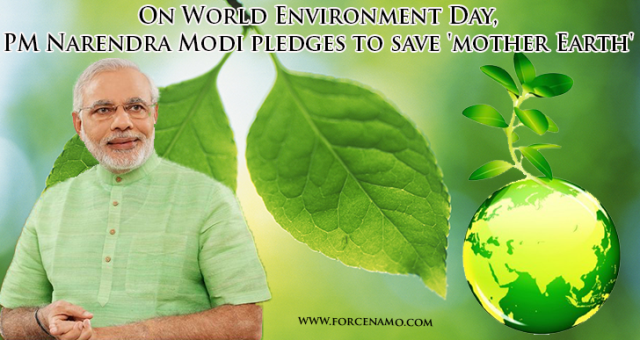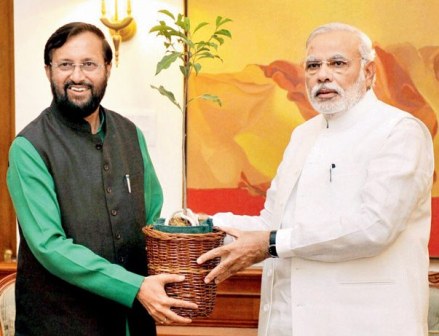The most disappointing and worrying aspect of the recent elections, for me, has been the almost complete absence of any debate or discussion on the environment.
Some parties, the BJP included, did make weak proforma noises about it in their manifestos but there was no mention of it in their campaigning.

Mr. Modi did take up the issue of cleaning the Ganga but I suspect this had more to do with extracting some politico-religious mileage out of his Hindu voters, and with show-casing his Sabarmati success by comparison.
In any case “cleaning” the Ganga as a step to protect the environment is as meaningful as a a face lift is to ensuring immortality. It is a cosmetic red-herring. The environment was not an issue in the elections, sadly.
I say “sadly” because environmental disaster is staring us in the face and yet all we can talk about are GDP, Growth, Employment, FDI – none of which is sustainable, by the way, without a sound, long-term, adequately funded programme to protect and preserve our environment.
Consider just a few of the documented, unimpeachable environment related realities that confront India today:
- Pollution levels in our cities have surpassed even China: 13 of the world’s 20 most polluted cities are in India. 50% of 290 Indian cities that were monitored have critical levels of air pollution. Outdoor pollution alone caused 6.20 lakh deaths in 2012.
- 76 of 150 major rivers in India are heavily polluted. The Yamuna in Delhi- the sanctum sanctorum of India’s policy making deities- is no longer a river- its an open sewer. The water in three fourths of our river is not fit for drinking.
- Most of India is water stressed, and ground water levels have dropped drastically to unsustainable levels thanks to illogical cropping choices, reckless and unregulated pumping from aquifers on the back of free electricity. 21 MILLION borewells have been drilled in the last 50 years – one borewell for every 60 Indians! Naturally, 30% of these wells in western India have gone dry. In Punjab too thousands of hectares of once fertile cropland, their underground water tables completely depleted, have turned alkaline and have been abandoned.
- We are firmly in the maws of climate change and the jaws are slowly closing. Our coastal regions are facing the near certainty of submergence and the displacement of tens of millions: the sea level has risen by 17 cms. in the past century and the rate is accelerating. Global temperatures have been rising by 0.05 celsius every decade since 1998 and and are projected to rise by 4.0 degree celsius by the turn of this century.Every study done so far postulates that the hardest hit will be South Asia where food production could decline by as much as 36%. The connection between food security and climate change is becoming more and more evident.
- The Himalayan glaciers that are the source of water for 400 million people in our northern plains are shrinking and may disappear completely by 2050.
- Project related displacement of populations is on the rise- more than 50 million people have been displaced between 1950 and 2000 due to dams and other infrastructural projects.
- Forest area is declining rapidly and the clamour for more dams in the Himalayan states and mining in the western ghats can only hasten their decimation. In just one year alone,2009, the area diverted for commercial projects was an astounding 87884 hectares, more than the area of Delhi! A recent report by John Vidal reveals that in the Indian Himalayas alone India proposes to construct 292 dams – one dam for every 32 Kms. of river channel! And all this devastation shall contribute just 6% of our projected energy needs, something which could be easily provided by nuclear or solar power projects with no adverse impact on the environment, if only we could plan better.
- It has been estimated by the World Bank that environmental degradation costs the Indian economy about 5.7% of its GDP, or US$ 120,000,000,000, every year. Incidentally, this rate is higher than our growth rate! Surely that is an economic argument for preserving our environment, if economics is all that we can comprehend?
- A recent World Bank survey of environment quality in 178 countries ranked India at 155.

And yet, over the last ten years we have allowed politicians, corporates and shrill TV anchors to hijack the debate and vilify the environment as the main impediment to economic utopia.
Environmental approvals, we are told, are responsible for stagnating coal production, power deficit, unemployment, lack of irrigation, inadequate infrastructure on our borders with China.
This is a motivated falsehood by corporate India intended to scare the government into relaxing norms (and it did succeed to some extent, witness Mr. Moily clearing Rs. 120, 000 crores worth of proposals in his last 40 days in office, including mining in an elephant reserve and a road through a tiger sanctuary!).
The actual facts tell a different story, notwithstanding Jairam Ramesh’s “Go-No go” policy and the Jayanti tax. According to a report in the Hindustan Times of 5th June 2014, in the period after 2004-05 to date, 99% of projects that applied for environment clearance received it, and 94% of projects got approval for cutting forests.
181 coal mines were given environmental clearance: their combined production capacity per annum is 583 million tonnes, more than the country’s current production! In addition 267 thermal power plants and 188 steel plants were also given environmental approval.
Any knowledgeable and concerned observer would consider these rates of approval far too high – and yet the environment is being made the scapegoat for failures that belong to other domains of governance.
To cite just one instance of where the real failure lies: between 1993 and 2008 as many as 195 coal blocks were allotted but only 30 of them are in production. Between 2004 and 2008 a total of 160 coal blocks were allotted but only 2 are in production.
Sticking with coal, it is constantly alleged that its production is suffering because the reserves are located in forest areas whose diversion is not forthcoming.
Nothing could be further from the truth.
According to a report by Greenpeace based on the Ministry’s own data coal reserves under forest areas are only 18.448 billion tonnes, whereas the total reserves in non-forest areas is 955.218 billion tonnes!
Take the power deficit
Of the installed capacity of 153288 MW (thermal, gas and oil) as in September 2013, as much as 40000 MW was not being generated!
This was not because coal or gas was not available but because of faulty linkages, inadequate transportation infrastructure, inability of bankrupt SEBs (State Electricity Boards) and Discoms (Power Distribution Companies) to pay, and ageing transmission systems unable to carry the required load.
Gujarat has offered to sell 2000 MW to other states but there are no takers, and yet just about every state has been facing daily power outages that last hours! How are delayed environmental approvals responsible for this mess?
Similarly with water. The same corruption, avarice, bad planning, mis-directed subsidies and indolence is creating a bigger scarcity than actually exists and leading to fool-hardy schemes (like the Inter linking of rivers project) that can only further devastate the environment.
Take the example of Delhi. Its daily demand for water is 1050 million gallons, the supply is about 800 million gallons.
In order to redress this shortfall, therefore it is taking the route that all short-sighted politicians and corrupt administrators usually do – divert a whole river in Himachal (the Giri) and bring its waters to flush Delhi’s toilets – an environmental nightmare.
Why is this necessary at all? Delhi has a population of about 15 million at most – according to the standard WHO norms it requires a daily water supply of about 1800 million litres, or 500 million gallons.
Its already getting 800 million – there is obviously a wastage, pilferage, call it what you will, of 300 million gallons per day.
Why not fix that instead of further burdening the environment?
The example of Delhi typifies what is wrong with the mindset of our planners, policy makers and administrators – instead of tackling and correcting inefficiencies on the demand and supply sides, we find it easier to exploit more and more of our natural assets, eliminating them one by one and further compounding the original problem.

Will Mr Modi Change This Mindset?
I have grave misgivings on this account because the few signals that his government has sent out so far are not encouraging. Lets look at some of them:
- The importance Mr. Modi attaches to the environment can perhaps be gleaned from the fact that the Ministry of Environment and Forests( MOEF) has been given only a part time Minister: Mr. Javadekar also has to handle Information and Broadcasting and Parliamentary Affairs. Given the tremendous challenges posed by global warming, climate change and the development-environment conflict, one would have expected a full-time Minister in charge of this portfolio.
- Both, Mr. Modi’s earlier criticism of the MOEF and Mr. Javadekar’s utterances post his taking over, seem to indicate that the current view is that the MOEF is a “road block for projects”. While the latter’s pledge to bring in transparency, accountability and time bound decision making is certainly to be welcomed after the malfeasance of the UPA govt., too much talk of “fast tracking” and “priority clearances” gives the impression that regulations will be weakened, and many categories exempted from environmental scrutiny. Reports suggest that a beginning in this regard has already been made by exempting defence projects in border areas from many levels of scrutiny and compliance.
- In a statement Mr. Javadekar said: ” I will treat jungles as wealth generating heritage of the country without exploiting them.” Even if we skip the obvious contradiction contained in the assertion that wealth can be generated from forests without exploiting them, we can distinctly see the Minister letting the cat out of the bag. He sees the forests as an asset from which ” wealth” can be generated( presumably coal, iron ore, bauxite?). This is a telling admission that the environmental values of forests have a lower priority in the govt’s scheme of things, and this cannot but worry all environmentalists.
- The targetting of NGOs who are opposed to mining in forest areas, damming of river flows, nuclear power plants, large scale project related displacement of populations on the basis of a 16 page IB report is not a good harbinger of things to come.NGOs are an essential component of civil society which has now become the fifth estate or pillar of democracy, and as important as the other four. They may be-and quite often are- wrong at times (I personally believe, for example, that the agitations against nuclear plants are short-sighted and ill-informed) but the right to protest against a govt. policy is part of the churning essential to a democracy and should not be curtailed for this reason alone. There are enough laws to regulate their funding and workings and the govt. should work within these laws to penalise violators, but merely opposing the govt. cannot by any means be a violation itself.
- The sudden decision to permit an increase of 17 metres in the height of the Narmada dam, to 138 metres, is baffling and indicative of a hubris that does not bode well for the future. A decades long protest has been contemptuously spurned within a month of the new govt. taking office. True, the Supreme Court has allowed the height to be increased. But this is not a legal issue: it is a social and environmental concern involving lakhs of people, something which the Court is ill equipped to arbitrate on. One would have expected the new govt. to engage with those opposing the height increase and then take a decision.
- Mr. Javadekar has shown the same alacrity in announcing that his govt. attaches the highest priority to the the inter-linking of river basins and will “take it forward.” One only hopes that his govt. has not already made up its mind on this and that it is willing to look at all impacts of this gargantuan exercise. As Darryl D’ Monte explains in his excellent article in the Hindustan Times of 19th June 2014, this would be the largest water development project in the world, linking 37 rivers through 12500 kms. of canals to provide 173 cubic billion meters of water from 3000 dams to irrigate 34 million hectares. Its cost in 2002 was estimated at Rupees 560,000 crores.It would displace as many millions as the Three Gorges project in China, whose catastrophic environmental impacts are beginning to be felt only now. Mr. Javadekar would do well to learn from the Chinese( and Russian) experience before committing himself to this venture. Rivers are not just water channels but eco-systems that sustain life along their lengths, recharging ground water, creating micro climates, occupying a niche devised by nature. Their diversion should not be seen as a mere engineering or technical problem: the social, political and environmental challenges posed need to be studied very carefully and with an open mind.Water sharing is a divisive subject and contains the potential for inter state and regional conflicts as the dispute between Tamil Nadu and Karnataka over sharing of Cauvery waters illustrates. There would be major ecological impacts for downstream states who would be suddenly deprived of these waters.
What, for example, would happen to the delta regions of Bangladesh and to the Sunderbans if all the ” surplus” waters of the Ganga were to be diverted to the south?
We object to China damming the Brahmaputra; why then should we expect Bangladesh to keep quiet when we take away its share of the Ganga waters?
If Haryana cannot spare a few cusecs for Delhi, and Mr. Modi himself could not part with a few Gir lions for UP how can we expect UP to spare the Ganga waters for any other state?
What will happen to the bio diversity of the Western Ghats if its west flowing rivers are forced to flow east to Tamil Nadu and Andhra?
How will we rehabilitate the lakhs who would be displaced given our miserable track record in this area and given that even those displaced by the Narmada project are yet to be fully rehabilitated?
There are tectonic issues involved here and one hopes that Mr. Modi will take his time to study and evaluate them, and to hold wide consultations (including with the much reviled NGOs), before going ahead with this project. Recklessness should not be confused with decisiveness.
Mr. Javadekar’s silence is as eloquent as his spoken words. He has not said a word about the Kasturirangan report on the Western Ghats, about which Mr. Moily was doing summersaults till his last day in office.

The Western Ghats are a treasure house of bio-diversity and one of the eight hottest “hot-spots” in the world. Parts of it have been declared as Natural Heritage Sites by UNESCO.
Covering an area of 164,280 sq.kms across six states, their environmental value is incalculable – they shape the climate of peninsular India, 58 rivers originate from its forests supplying water to 250 million people in these states, its green cover sequesters ten million tonnes of carbon every year.
But it is severely endangered and has shrunk by 25% over the past two decades. The Kasturirangan panel, set up by the MOEF itself, recommended last year that 37% of the area of the Ghats be declared as Ecologically Sensitive Areas( ESA) where no settlement or projects would be allowed.
This is indeed the bare minimum needed to protect the core values of the Ghats and much less than the 64% proposed by the earlier Gadgil panel.
But even this is being opposed by all the six states under pressure from the mining, timber and construction lobbies. Mr. Moily had put the panel’s recommendations on hold.
Why is Mr. Javadekar not removing the embargo placed by Mr. Moily on accepting the Kasturirangan panel’s eminently sensible recommendations?
Why this silence when every other decision of the UPA govt. has been brought under the scanner?
We would have expected Mr. Javadekar to announce his government’s acceptance of the Kasturirangan report before moving onto new initiatives. His silence is disconcerting.
It is no secret that Mr. Modi is an admirer of the China model of development and is keen to replicate it in India (at least the less totalitarian parts of it!).
He would do well, therefore, to study the initiatives adopted by China to tackle the environmental impacts of its growth trajectory.
At one point China was losing 9% of its GDP to environmental and natural resource degradation, the WHO had estimated that air and water pollution had reduced life expectancy by as much as five and a half years, almost 10% of its farmland is contaminated with heavy metals, the water in one third of its rivers was not even fit for agriculture.
But China has had the wisdom to realise that this model of growth was just not sustainable; it has had the courage to take a step back and initiate sincere reforms to mitigate the disastrous effects of its mad race for economic development.
As reported in the Economist of 10th August 2013 it has, over the last two years, given more teeth to its environmental laws and provided for imprisonment for violators, officials are now assessed not just on financial performance but also on environmental parameters, the government has provided $ 275 billion for cleaning up the air over the next five years, it has targetted to generate 20% of its power from renewables by 2020 and spent $67 billion in 2012 on just developing wind and solar power.
It has reduced carbon intensity (emissions per unit of GDP) by 20% in the last few years and plans to cut it by 45% by 2020. It is also contemplating to put an absolute cap on total energy consumed.
The China model is an evolving one and the redressal mechanisms mentioned above are part of it.
Mr. Modi is better positioned than China in this respect: he can learn vicariously from China’s experience and not repeat the mistakes that China had made in its frantic gold rush.
He does not have to further devastate our natural resources, he can immediately set in motion the redressal measures needed: if he shows the vision to do so he can still retrieve our environment.
He needs to strengthen, not weaken, regulatory mechanisms for the environment; he needs to review all dam projects in the Himalayas; he needs to set up an expert council on climate change; he needs to seriously ponder over how much green cover we can afford to lose in the pursuit of GDP; he needs to draw the Obama red line around all Protected Areas; he needs to make environment protection laws more stringent and to send violators to jail; he needs to concentrate more on renewable energy.

There is so much for him to do in this respect that even his 18 hour day may become a tight fit. But if anyone can do it Mr. Modi can.
I have absolutely no doubt that Mr. Modi will be around for at least the next ten years.
This is also the critical period when we can either preserve our environment or devastate it to the point of no return.
In every other area of governance Mr. Modi has shown that he possesses the vision, integrity, leadership qualities, decision making ability, courage, connect with the people and self belief which alone can deliver a better (in every sense) life to all Indians.
It is now time for him to demonstrate these same qualities in the cause of preserving the country’s natural wealth, ecology and environment.
To be brutally honest the signals so far have not been encouraging.
| The author retired from the IAS in December 2010. A keen environmentalist and trekker he has published a book on high altitude trekking in the Himachal Himalayas: THE TRAILS LESS TRAVELLED.
His second book- SPECTRE OF CHOOR DHAR is a collection of short stories based in Himachal and was published in July 2019. His third book was released in August 2020: POLYTICKS, DEMOCKRAZY AND MUMBO JUMBO is a compilation of satirical and humorous articles on the state of our nation. His fourth book was published on 6th July 2021. Titled INDIA: THE WASTED YEARS , the book is a chronicle of missed opportunities in the last nine years. Shukla’s fifth book – THE DEPUTY COMMISSIONER’S DOG AND OTHER COLLEAGUES- was released on 12th September 2023. It portrays the lighter side of life in the IAS and in Himachal. He writes for various publications and websites on the environment, governance and social issues. He divides his time between Delhi and his cottage in a small village above Shimla. He blogs at http://avayshukla.blogspot.in/ |




Wow ! I could not have accumulate this much of information related to our environment from any other source. Excellent write up, hope Modi Government will take notes from this and try to save the environment. Keep writing Sir, your views are indeed thought provoking.